研究紹介

粒子モデル(ミクロモデル)とMHDモデル(マクロモデル)をつなぐ階層連結シミュレーションによるプラズマ中の磁力線つなぎ替え(磁気リコネクション)シミュレーション。 |
基礎物理シミュレーション研究系はスーパーコンピュータを用いた先端的シミュレーション研究を推進しています。バーチャルリアリティによる3次元空間での表現法などの 関連分野の研究も同時に進め、核融合プラズマの総合的なシミュレーションの実現を目指しています。
また、基礎物理シミュレーション研究系では、プラズマ・核融合に関する様々な物理過程を新しいシミュレーション手法を駆使して研究しています。左図は連結階層シミュレーション手法によるプラズマ中の磁力線のつなぎ替え(磁気リコネクション)のシミュレーション結果を示しています。 |
最近の論文紹介
"Numerical Investigation on Applicability of jC-Measurement Method
to Multiple High-Temperature Superconducting Tape"
T. Yamaguchi, H. Ohtani, S. Satake, N. Yanagi, and Y. Onodera,
Plasma and Fusion Research Vol. 17, 2405035 (2022)
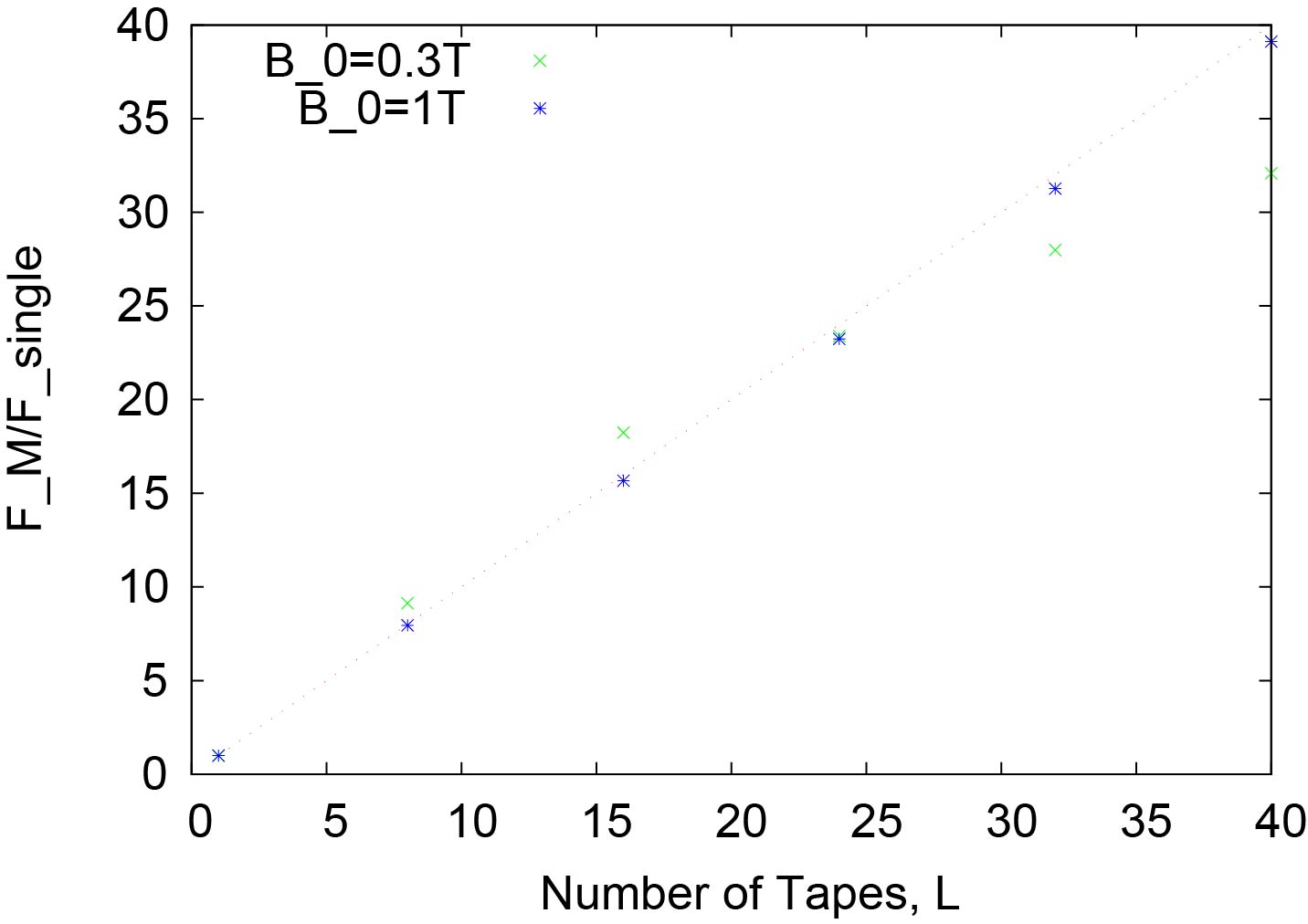
We develop a numerical code based on the edge-based finite element method
to investigate the applicability of the permanent magnet method to vertically-stacked
multiple high-temperature superconducting (HTS) tapes. The permanent magnet
method can measure the critical current density in the HTS tape contactlessly
and nondestructively. By using our numerical code, it is clear that the
permanent magnet method can be applied to measurement of the critical current
density in the multiple HTS tapes although there is an upper limit of the
number of HTS tapes in which the critical current density can be measured.
In addition, by using stronger magnet, the permanent magnet method can
measure the critical current density when more number of HTS tapes are
stacked. |
"Virtual-reality visualization of loss points of 1 MeV tritons in
the large helical device, LHD"
H. Ohtani, S. Masuzaki, K. Ogawa, and S. Ishiguro,
Journal of Visualization Vol. 25, 281 (2022)
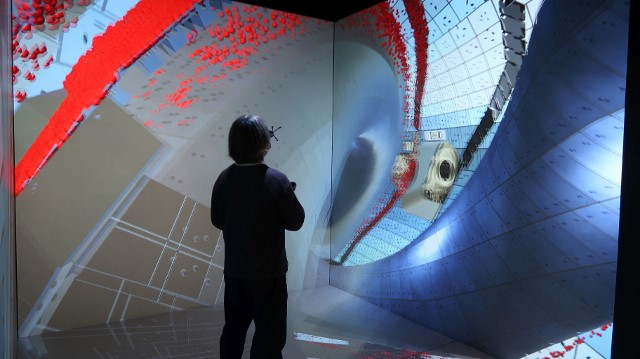
Intersection points of 1 MeV tritons and the plasma facing wall are
visualized in the vacuum vessel of Large Helical Device (LHD) with the
divertor plates by the virtual-reality (VR) system. It is possible to
directly observe the strike points distributed on the wall and on the
plates. This visualization helps us to determine where the material
probes should be placed on the plasma facing wall in the real LHD for
experimental analysis of the accumulated tritium on the plasma facing wall.
|
| 2021年 |
"Linear analysis of cross-field dynamics
with feedback instability
on detached divertor plasmas"
H. Hasegawa, H. Tanaka, and S. Ishiguro,
Nuclear Fusion Vol. 61, 126005 (2021)
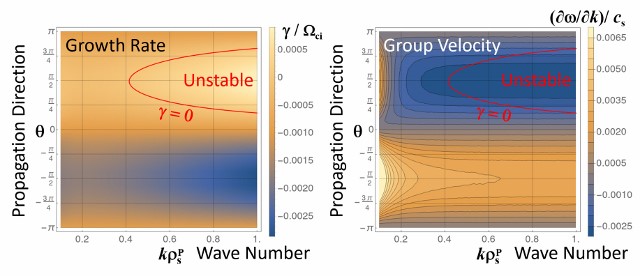
The theoretical model of the feedback instability is proposed to explain
the mechanism of the correlation between the detachment and the cross-field
plasma transport. It is shown that the feedback instability on the detached
divertor plasma can be induced in a certain condition in which the volume
recombination frequency is larger than the ion cyclotron frequency in the
recombination region (see the left figure). The feedback instability can
provide the cross-field plasma transport in the boundary layer of magnetic
fusion torus devices (see the right figure). Furthermore, the properties
of the radial transport observed in the NAGDIS-II linear device experiment
are compared with the estimation by the feedback instability model. The
dependence of the feedback instability mode on the total collision frequency
and the recombination coefficient and the density gradient has been also
investigated. |
|
| 2019年 |
"Dependence of the pickup-like ion effective heating on the poloidal
and toroidal magnetic fields during magnetic reconnection"
S. Usami, R. Horiuchi, H. Ohtani, Y. Ono, M. Inomoto, and H. Tanabe,
Physics of Plasmas Vol. 26, 102103 (2019)
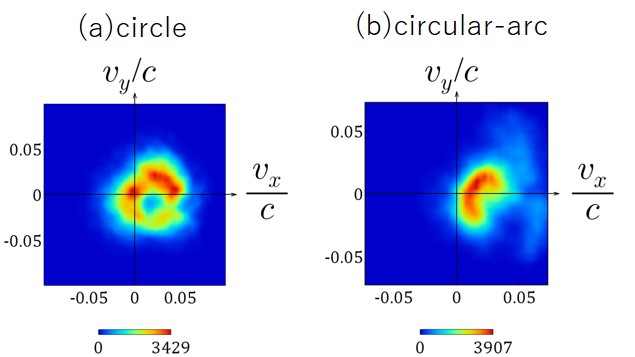
We have discovered that ions form circle/arc-shaped velocity distributions
(see the above figure) in the downstream of magnetic reconnection. The
dependence of the circle/arc-shaped velocity distributions on the magnetic
fields is investigated by means of particle simulations. The radius and
central angle of circle/arc depend on the poloidal and toroidal magnetic
fields, respectively. The tendencies account for results of plasma merging
experiments in STs. |
"Magnetic flux coordinates for analytic high-beta tokamak equilibria
with flow"
A. Ito and N. Nakajima,
Plasma Physics and Controlled Fusion Vol. 61, 105006 (2019)

Poloidal profiles of the pressure on each flux surface for equilibria without
flow (left), with sub-sonic (center) and super-sonic (right) poloidal flows.
The pressure profiles in the poloidal direction on each flux surface become
non-constant due to flow. The transition occurs between sub- and super-sonic
poloidal flows. |
"Three-dimensional effect of particle motion on plasma filament dynamics"
H. Hasegawa and S. Ishiguro,
Physics of Plasmas Vol. 26, 062104 (2019)

It is shown for the first time with the three-dimensional electrostatic
particle-in-cell simulation that the plasma particle motion influences
plasma filament dynamics three-dimensionally. In the high Ti case, the
pre-sheath potential drop on the potential hill in the filament cross-section
becomes larger than that on the potential well. The large pre-sheath drop
on the hill side induces the strong dependence of the perpendicular electric
field in the filament on the toroidal position. The filament dynamics in
the high Ti case, in which the poloidal symmetry breaking occurs, are significantly
influenced by such a 3D structure of the electric field as shown in the
above figure. |
"Impurity Ion Transport by Filamentary Plasma Structures"
H. Hasegawa and S. Ishiguro,
Nuclear Materials and Energy Vol. 19, 473 (2019)

This study has investigated the dependence of the impurity ion transport
by a plasma filament on various parameters with the three-dimensional (3D)
Particle-in-Cell (PIC) simulation; (1) The effective diffusivity of impurity
ions has a positive correlation
with the filament poloidal size (Fig. (a)). (2) The effective diffusivity
of impurity ions has a slight inverse correlation with the ion temperature
(Fig. (b)). (3) The effective diffusivity of impurity ions becomes quite
small in the heavy impurity ion mass case (Fig. (c)). |
| 2018年 |
"Improvement of the Multi-Hierarchy Simulation Model Based on the
Real-Space Decomposition Method"
S. Usami, R. Horiuchi, H. Ohtani, and M. Den,
Plasma Vol. 1, 90 (2018)
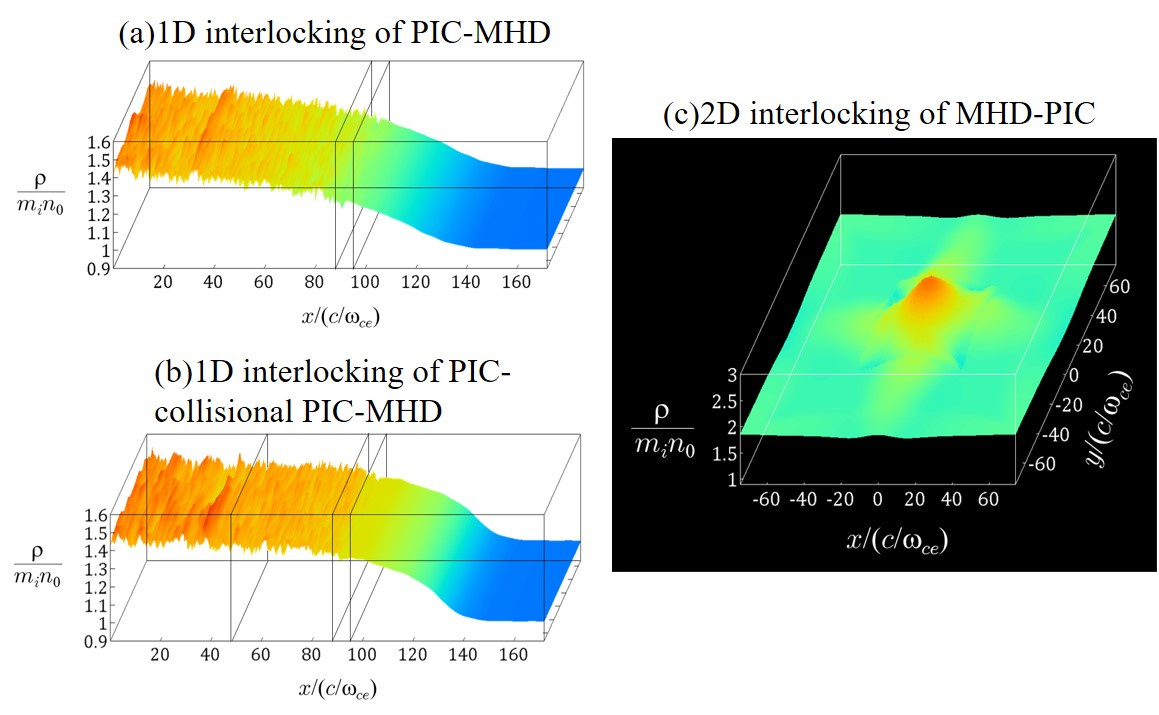
The multi-hierarchy model by the authors is improved to three types of
new models, i.e., two types of the 1D interlocking with the downstream
condition (Figs.(a)(b)) and one type of the 2D interlocking with the upstream
condition (Fig.(c)). For their verification, simulations of plasma propagation
across the multiple domains were performed and it was confirmed that the
new interlocking methods are physically correct. |
"Microscopic Effect on Filamentary Coherent Structure Dynamics in
Boundary Layer Plasmas"
H. Hasegawa and S. Ishiguro,
Plasma Vol. 1, 61 (2018)

This study has demonstrated kinetic behaviors on the plasma filament propagation with the three-dimensional (3D) Particle-in-Cell (PIC) simulation. When the ion-to-electron temperature ratio Ti / Te is higher, the poloidal symmetry breaking in the filament propagation
occurs due to the unbalanced potential structure which arises from the
effect of the gyro motion of plasma particles. The poloidal symmetry breaking
disturbs the radial propagation of a filament. The ratio between the observed
and theoretical radial propagation velocities has a linear relation with
the square of the difference between the ion and electron gyro radii. |
"Numerical analysis of two-fluid tearing mode instability in a finite
aspect ratio cylinder"
A. Ito and J. J. Ramos,
Physics of Plasmas Vol. 25, 012117 (2018)
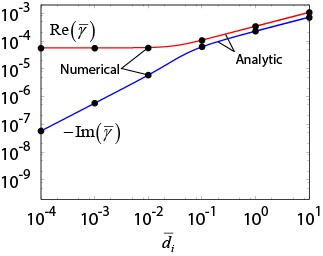
The two-fluid resistive tearing mode instability in a periodic plasma cylinder
of finite aspect ratio is investigated numerically. The real and imaginary
parts of the mode growth rate and the eigenfunctions are comparable for
parameters such that the cylindrical aspect ratio and two-fluid effects
are of order unity. |
|
| 2017年 |
"Effect of polycrystalline structure on helium plasma irradiation
to tungsten materials"
S. Saito, H. Nakamura, S. Yooyen, N. Ashikawa, and K. Katayama,
Japanese Journal of Applied Physics Vol. 57, 01AB06 (2017)
Binary-collision-approximation-based (BCA-based) simulation is performed
for the investigation of the effect of polycrystalline structure on the
penetration depth, the absorption rate, and the sputtering yield of tungsten
materials irradiated by helium plasma. To clarify the possibility of suppressing
the generation of helium bubbles in tungsten materials by designing the
polycrystalline structure such as grain size, the effect of polycrystalline
structure on the helium bubble formation is also investigated.
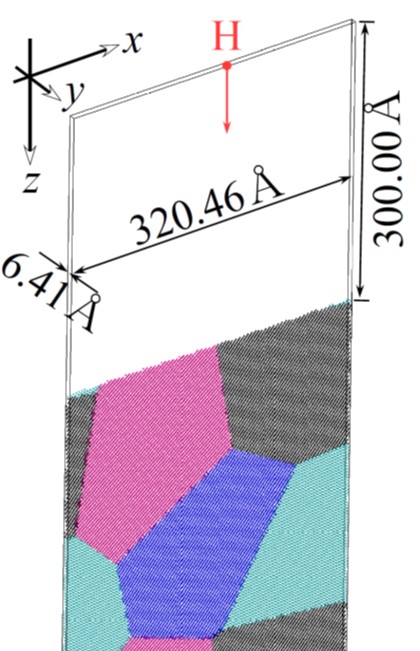
Fig: Simulation model of helium injection into polycrystalline tungsten
with the xyz coordinates of our simulation. |
"Applications of virtual-reality technology to fusion science and
engineering"
H.Ohtani and S.Ishiguro,
Proceedings of 36th JSST Annual International Conference on Simulation
Technology, 194 (2017)
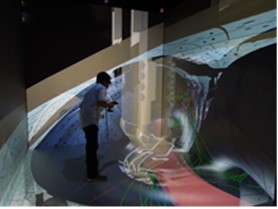
We have developed a system in which the plasma simulation results are shown
together with the experimental observation data in the reactor design data.
This system promotes the viewer’s under-standing..

We can seek the efficient assembly and replacement procedures by investigating
the component movements including the robot motion in the VR space previously.
The VR technology is expected to play an important role in the fusion reactor
operation, such as design, construction, and maintenance. |
"Development and Verification of the Three-Dimensional Electrostatic
Particle Simulation Code for the Study of Blob and Hole Propagation Dynamics"
H. Hasegawa and S. Ishiguro,
Plasma and Fusion Research Vol. 12, 1401044 (2017)
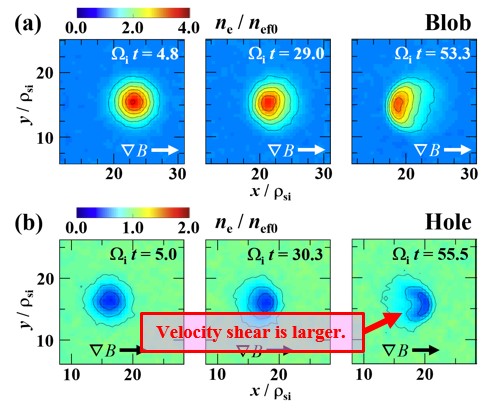
The three-dimensional (3D) electrostatic particle-in-cell (PIC) simulation
code for the study of blob and hole propagation dynamics has been developed
and verified; (1) the observed relations between the propagation speed
and the structure size in the blob and hole simulations are in good agreement
with the theoretical relations, (2) the code has reproduced a larger distortion
of a hole shape than that of a blob shape as shown in the figure, and (3)
the code has shown that the propagation of a blob or a hole is faster without
end plates (Such a situation is similar to the detached state). |
"Impurity transport caused by
blob and hole propagations"
H. Hasegawa and S. Ishiguro,
Nuclear Fusion Vol. 57, 116008 (2017)
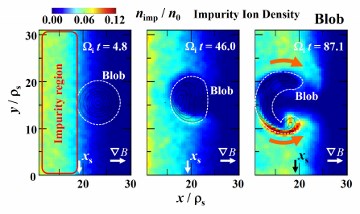
In this study, the dynamics between impurity ions and the blob and hole
structures have been investigated with the three-dimensional electrostatic
particle-in-cell simulation. The simulations have shown the following facts:
(1) The dipolar profile of impurity ion density in the blob / the hole
is formed. (2) Such a density profile propagates with the blob/ the hole.
(3) The effective radial diffusion coefficient for impurity ions by a single
blob / hole is comparable to the Bohm diffusion coefficient (the figure
shows impurity ion tranport by a blob). |
"Numerical simulations of interchange/tearing instabilities in 2D
slab with a numerical model for edge plasma"
H. Miura, L. Zheng, and W. Horton,
Physics of Plasmas Vol. 24, 092111 (2017)
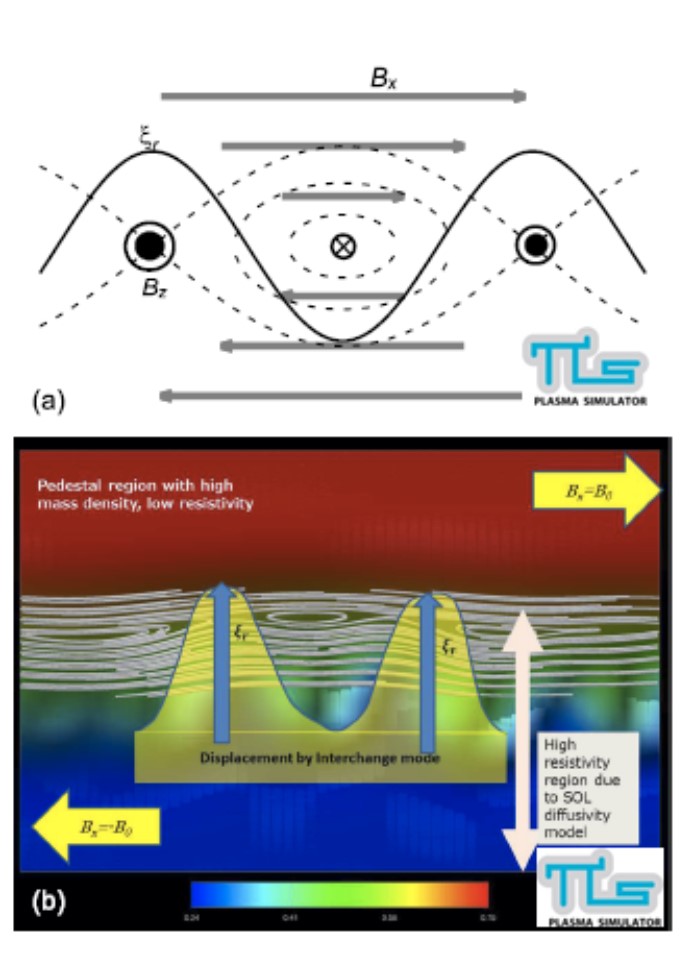
Fig: (a) A schematic view of the current interchange-tearing mode drawn
with the magnetic field lines. (b) The contours of mass density in a small
computational domain, drawn with a schematic line of the displacement xr. (Copied from Fig.5 of the article.) |
"Effective heating of nonadiabatic protons in magnetic reconnection
with a guide field"
S. Usami, R. Horiuchi, and H. Ohtani,
Physics of Plasmas Vol. 24, 092101 (2017)
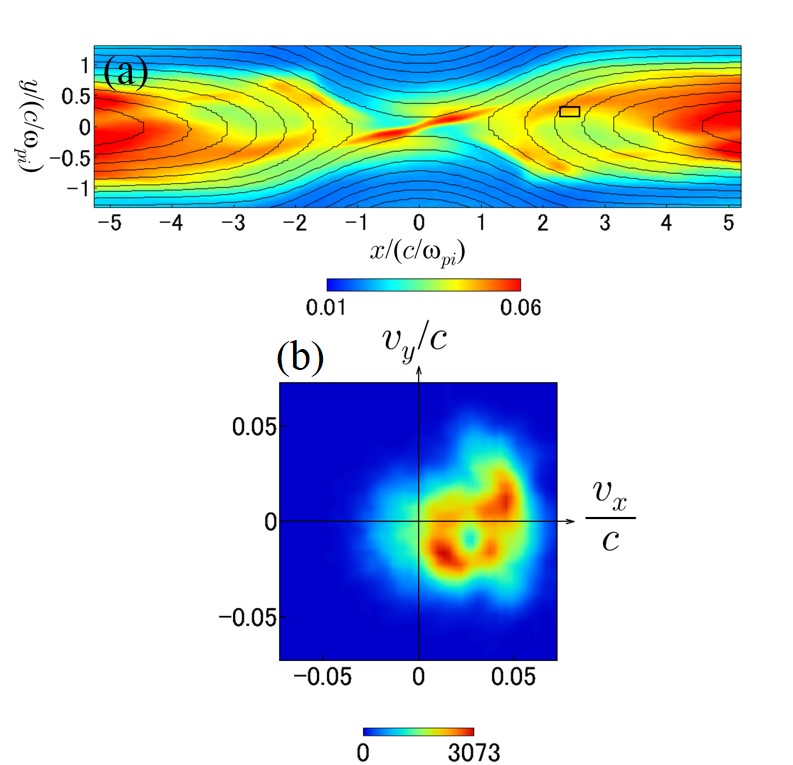
Mechanism of ion heating through magnetic reconnection with a guide magnetic
field is investigated by means of electromagnetic particle simulations.
Figure (a) shows the spatial profile of the ion temperature and Fig. (b)
displays the ion velocity distribution at the boxed area. It is observed
that the iontemperature is increased in the downstream, where a ring-like
structures of the ion velocity distributions is formed. Therefore, we can
see that ions are effectively heated. |
"Two-fluid tearing mode instability in cylindrical geometry"
A. Ito and J. J. Ramos,
Physics of Plasmas Vol. 24, 072102 (2017)
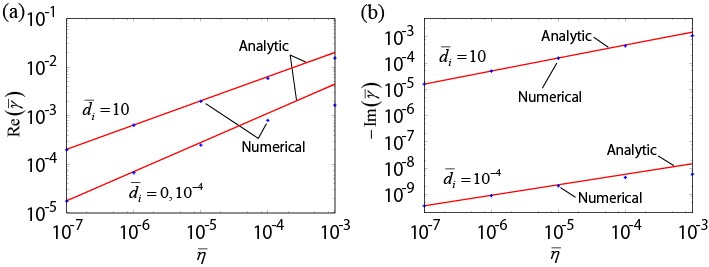
The cylindrical dispersion relation for the resistive two-fluid tearing instability shows the dependence of the mode growth rate and real frequency on the ion skin depth, through different regimes that range from the single-fluid MHD limit to the electron MHD limit. The numerically obtained eigenvalues agree very well with the analytic dispersion relation and the agreement improves the smaller the resistivity and the larger the ion skin depth are. |
"Two-fluid sub-grid-scale viscosity in nonlinear simulation of ballooning
modes in a heliotron device"
H. Miura, F. Hamba, and A. Ito
Nuclear Fusion Vol. 57, 076034 (2017)
A large eddy simulation (LES) approach is introduced to enable the study
of the nonlinear growth of ballooning modes in LHD. A model to substitute
the influence of scales smaller than the grid size, at sub-grid scale (SGS),
and at the scales larger than it - grid scale (GS) - has been developed
for LES. The LESs of two-fluid MHD equations with SGS models have successfully
reproduced the growth of the ballooning modes in the GS and nonlinear saturation.
The introduction of the LES approach has reduced the computational cost
drastically.
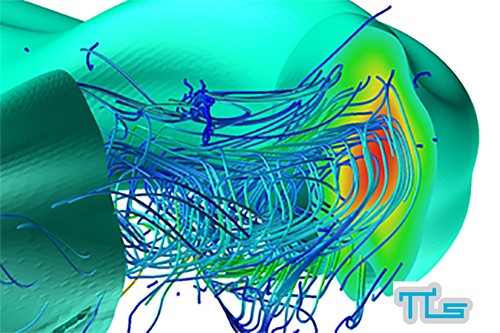
Fig: Pressure isosurface, contours and streamlines in a two-fluid LES of ballooning modes in LHD, for b0 = 3.6% and Rax = 3.6 m unstable equilibrium. |
| 2016年 |
"Parameter dependence of two-fluid and finite Larmor radius effects
on the Rayleigh-Taylor instability in finite beta plasmas"
A. Ito and H. Miura,
Physics of Plasmas Vol. 23, 122123 (2016)
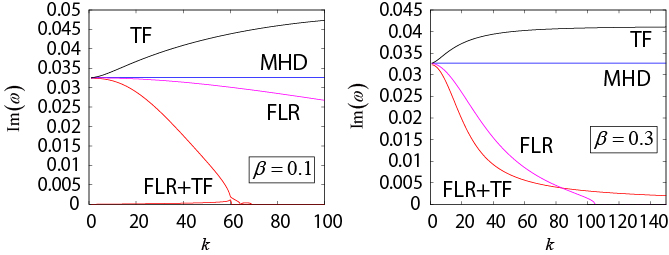
Growth rates of the Rayleigh-Taylor instability as functions of the wavenumber
for different MHD models. For the two-fluid MHD model with the FLR term,
it is shown that the absence of complete stabilization occurs for the beta
different from that for the MHD model with the FLR term, the mode is not
always most stable among those for the other models, depending on beta. |
|
| 2015年 |
"Study of self-consistent particle flows
in a plasma blob with particle-in-cell simulations"
H. Hasegawa and S. Ishiguro,
Physics of Plasmas Vol.22, 102113 (2015)

In this study, the presence of the spiral current system composed of the
diamagnetic and parallel currents in a blob is confirmed by the particle
simulation without any assumed sheath boundary models (see the left figure).
Furthermore, we have observed that the temperature structure in a blob
is formed by the potential structure (see the electron velocity distributions
in the right figure). |
"Molecular dynamics and Monte Carlo hybrid simulation for fuzzy tungsten
nanostructure formation"
A.M. Ito, A. Takayama, Y. Oda, T. Tamura, R. Kobayashi, T. Hattori, S.
Ogata, N. Ohno, S. Kajita, M. Yajima, Y. Noiri, Y. Yoshimoto, S. Saito,
S. Takamura, T. Murashima, M. Miyamoto and H. Nakamura,
Nuclear Fusion Vol.55, 073013 (2015)

Fuzzy nanostructure on the surface of tungsten materials is generated by
exposure to helium plasma. The formation process of the fuzzy nanostructure
had been successfully reproduced by Molecular Dynamics and Monte-Carlo
hybrid (MD-MC hybrid) simulation. |
"Effects of trapped electrons on ion reflection in an oblique shock
wave"
M. Toida and J. Inagaki,
Physics of Plasmas Vol.22, 062305 (2015)
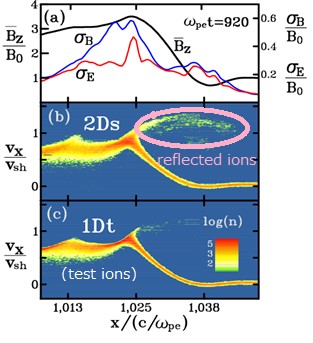
A magnetosonic shock wave propagating obliquely to the magnetic field can
trap electrons and accelerate them to ultrarelativistic energies. These
electrons excite multi- dimensional fluctuations, which significantly influence
electron motions.
Effects of trapped electrons on ion motions in an oblique shock wave have
been investigated with particle simulations. It is found that the number
of accelerated ions via reflection from the shock front is increased because
of the multi-dimensional fluctuations excited by the trapped electrons.
The figure shows the phase space plots of ions [(b) 2Ds] and test ions
[(c) 1Dt] which do not feel multi-dimensional fluctuations. The ions with
vx > vsh are reflected. |
"Formation of large-scale structures with sharp density gradient through
Rayleigh-Taylor growth in a two-dimensional slab under the two-fluid and
finite Larmor radius effects"
R. Goto, H. Miura, A. Ito, M. Sato, and T. Hatori,
Physics of Plasmas Vol.22, 032115 (2015)
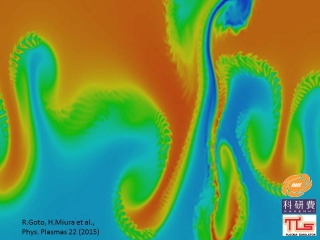
Density contours in a 2D extended MHD simulation of the Rayleigh-Taylor
instability. It is observed that the secondary Kelvin-Helmholtz-type instability
forms fine wavy structures along the density contours. |
| 2014年 |
"Multi-Hierarchy Simulation of Collisionless Driven Reconnection by
Real-Space Decomposition"
S. Usami, R. Horiuchi, H. Ohtani, and M. Den,
Journal of Physics: Conference Series Vol.561, 012021 (2014)

Spatial profiles of the magnetic field lines. By means of our multi-hierarchy simulations, the influence of macroscopic dynamics on microscopic physics of magnetic reconnection is investigated. Dynamical behaviours of reconnection that is, steay reconnection (Fig.(a)) or intermittent reconnection (Fig. (b)) depend sensitively on plasma inflows from the MHD domain. |
"Structure transitions induced by the Hall term in homogeneous and
isotropic
magnetohydrodynamic turbulence"
H. Miura and K. Araki,
Physics of Plasmas Vol.21, 072313 (2014)
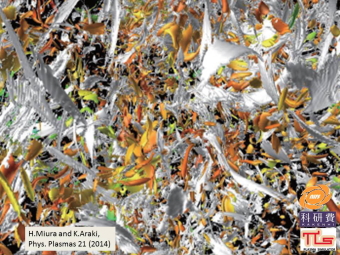
Isosurfaces of the enstrophy density (colored) and the current density
(grey) in freely decaying homogeneous and isotropic Hall MHD turbulence
in a simulation of 10243 grid points. |
| 2013年 |
"Suppression effects of Weibel instability for fast electron divergence"
H. Sakagami, T. Johzaki, T. Taguchi and K. Mima,
EPJ Web of Conference Vol.59, 17016 (2013)
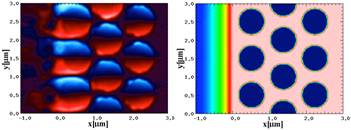
As the growth rate of the Weibel instability is absolutely large, little
suppression effects can be expected even if the background electron temperature
increase to more than 100 keV. This magnetic field does not remain at rest
and shows turbulent behaviors, enhancing the divergence of fast electrons.
To control the location of Bz, punched out targets are introduced, where
many vacuum holes are punched out as shown in left Figure. Background electrons
that carry the return current can only flow in the gaps between holes,
because the sheath field prevents them from crossing over the hole. Thus
stable magnetic fields are induced and grow up to almost ±300 MG, which
are shown in right figure. Fast electrons go forward with a meandering
motion, and reduction of divergence can be expected. Unfortunately, this
structure simultaneously disturbs fast electron propagation, and the fast
electron beam intensity also decreases because the number of electrons
in such energy range is reduced. |
"Development of Multi-Hierarchy Simulation Model with Non-Uniform
Space Grids for Collisionless Driven Reconnection"
S. Usami, R. Horiuchi, H. Ohtani, and M. Den,
Physics of Plasmas Vol.20, 061208 (2013)
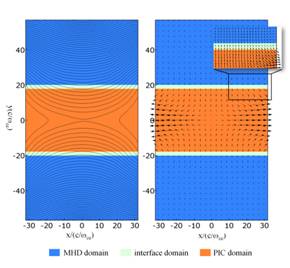
Multi-hierarchy simulation result of magnetic reconnection. The left and
right panels display magnetic field lines and fluid velocity vectors. The
multi-hierarchy model is progressed from the previous model as follows.
First, the boundary condition in the downstream is improved from periodic
to open, thus outflow can go out across the downstream boundary. Furthermore,
non-uniform space grids are adopted in the macro hierarchy so as to calculate
larger region. |
"Analytic Equilibria of High-Beta Tokamaks with Toroidal and Poloidal
Flows and Pressure Anisotropy Associated with Parallel Heat Flux"
A. Ito and N. Nakajima,
Journal of the Physical Society of Japan Vol.82, 064502 (2013)
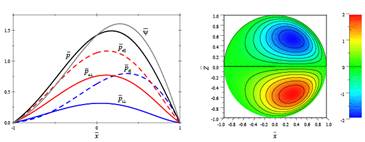
Profiles of pressures and the magnetic flux in the midplane (left) and
the radial component of the diamagnetic current in a poloidal cross section
(right) obtained from the analytic solution for tokamak equilibria with
flow and pressure anisotropy. |
"Formation and Classification of Amorphous Carbon by Molecular Dynamics
Simulation"
A. M. Ito, A. Takayama, S. Saito, and H. Nakamura,
Japanese Journal of Applied Physics Vol.52, 01AL04 (2013)

(Color online) Animation snapshots in the MD simulation for transition
from graphite to diamond at a pressure of 15 GPa. The green and red spheres
indicate sp2 and sp3 carbon atoms, respectively. The white lines show the side of the simulation
box under the periodic boundary condition. |
"Kinetic effects on robustness of electron magnetohydrodynamic structures"
M. Hata, H. Sakagami, and A. Das,
Physics of Plasmas Vol.20, 042303 (2013)
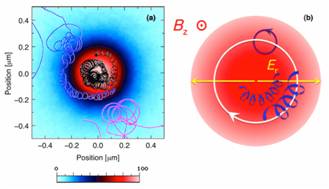
(a) Electron orbit in the case of R=8 at the temperature of 4 keV, where
black, blue, and pink lines indicate orbits and color contour represents
magnetic field in the z direction.
(b) Schematic for sustained mechanism of electron's orbit, where red shading
and yellow arrows express magnetic field in the z direction and radial
electric field, and purple and white circles and blue-drifted-circle represent
Larmor motion, circular motion via ExB drift, and electron orbit that results
from Larmor motion and ExB drift, respectively. |
"Macro- and microphysics of magnetic reconnection in a multi-hierarchy
open system"
R. Horiuchi, M. Den, T. Tanaka, H. Ohtani, and S. Usami,
Plasma Physics and Controlled Fusion Vol.55, 014008 (2013)
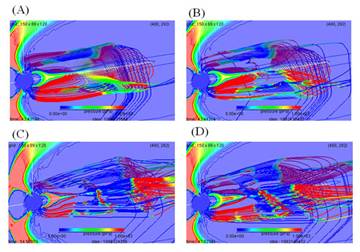
Global MHD simulation of geomagnetosphere reconnection with kinetic resistivity.
Spatial profiles of magnetic field lines and pressure are plotted when
reconnection sets in (top panels) and when flux rope is formed (bottom
panels). The left and right panels stand for the results for an effective
resistivity model based on steady collisionless driven reconnection, and
those for a constant resistivity model. Color on the lines presents the
Bz intensity. |
| 2012年 |
"Visualization of Particle Trajectories in Time-Varying Electromagnetic
Fields by CAVE-Type Virtual Reality System"
N. Ohno, H. Ohtani, D. Matsuoka, R. Horiuchi,
Plasma and Fusion Research Vol.7, 1401001 (2012)

CAVE visualization of the time-varying data at (1) T=0, (2) 25 T, and (3)
50ΔT, where ΔT is time interval of storing the simulation data. The color
contours on xy and yz planes are ion temperature and a reconnection component
of magnetic field, respectively. The blue and white lines are magnetic
field and ion trajectories, respectively. The magnetic field lines are
drawn by the data at the each time, while the ion trajectories are shown
as time-tracing lines from T=0. |
"Effects of long rarefied plasma on fast electron generation for FIREX-I targets"
H. Sakagami, A. Sunahara, T. Johzaki, and H. Nagatomo,
Laser and Particle Beams Vol.30, 103-109 (2012)
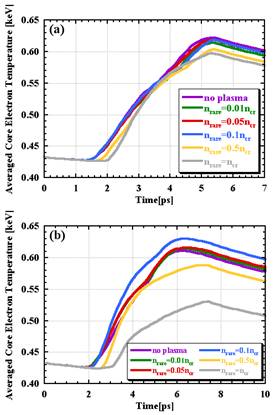
These figures show time evolutions of averaged core electron temperature
over the dense region (ρ>10 g/cm3) without rarefied plasmas(purple)
and with rarefied plasmas of different densities, 0.01(green), 0.05(red),
0.1(blue), 0.5(yellow) and 1(gray) critical density for (a) Lrare=150 and
(b) 300 μm. |
"Simulation of Plasma Flow Injection with Multi-Hierarchy Model Aiming Magnetic Reconnection Studies"
S. Usami, H. Ohtani, R. Horiuchi, and M. Den,
Communications in Computational Physics Vol.11, 1006-1021 (2012)
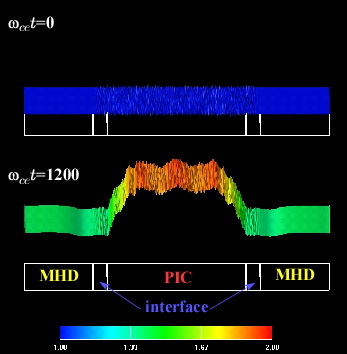
Bird's eye view of the mass density in the multi-hierarhcy simulation. At the initial state, mass density is uniform. Plasmas smoothly and continuously flow from the MHD to PIC domains through the interface domain. |
|
| 2011年 |
"Visualization of Three-Dimensional MHD Simulation Data to Study Fine
Unstable Motions in a Helical Torus Device"
H. Miura,
IEEE TRANSACTIONS ON PLASMA SCIENCE, Vol.39 (2011)
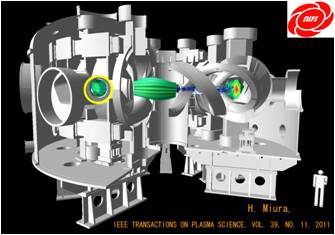
Isosurfaces of the pressure in a 3D MHD simulation of a hot magnetized
plasma dominated by the ballooning instability are visualized. The flute-like
structures of the isosurfaces indicates growth of the ballooning mode.
The yellow circle indicates the tangential port of the LHD. |
"Equilibria of toroidal plasmas with toroidal and poloidal Flow in
high-beta
reduced magnetohydrodynamic models"
A. Ito and N. Nakajima,
Nuclear Fusion Vol.51, 123006 (2011)
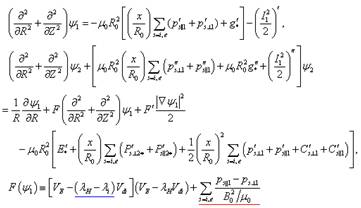
Grad-Shafranov type equations for high-beta toroidal equilibria with toroidal
and poloidal flow, two-fluid and finite Larmor radius effects and pressure
anisotropy. |
"Scientific Visualization of Plasma Simulation Results and Device Data in Virtual-Reality Space"
H. Ohtani, Y. Tamura, A. Kageyama, and S. Ishiguro,
IEEE Transactions on Plasma Science Special Issue - Images in Plasma Science
2011, Vol.39 (11) 2472-2473 (2011)

Scientific visualization of the equilibrium plasma in the Large Helical
Device (LHD) with the realistic description by the virtual-reality system
`CompleXcope.' Blue surface shows the isosurface of plasma pressure. Green
and magenta lines are the single magnetic-field line and single particle
orbit, respectively. |
"Hybrid Simulation between Molecular Dynamics and Binary Collision
Approximation Codes for Hydrogen injection into Carbon Materials"
S. Saito, A. M. Ito, A. Takayama, T. Kenmotsu, and H. Nakamura,
Journal of Nuclear Materials, doi:10.1016/j.jnucmat.2010.12.233, (2011)
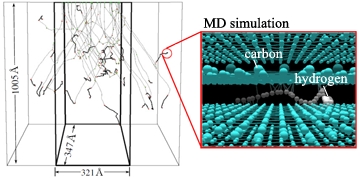
The left panel shows thirty trajectories of incident hydrogen that moves in a graphite material calculated by BCA-MD hybrid simulation. The gray and black lines in the left panel are obtained by the binary collision approximation (BCA) and the molecular dynamics (MD) simulation, respectively. The right panel shows a detailed image of the MD simulation part. |
| 2010年 |
"Multi-scale simulation for plasma science"
S. Ishiguro, S. Usami, R. Horiuchi, H. Ohtani, A. Malukov, and M. M. Skoric,
Journal of physics: Conference Series Vol. 257, 012026 (2010)
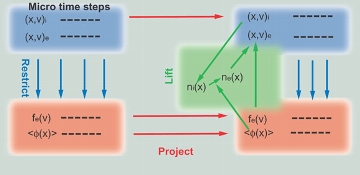
Structure of primal Equation Free Projective Integration PlasmaSimulation. |
"Simulation Data Analysis by Virtual Reality System"
H. Ohtani, N. Ohno, N. Mizuguchi, M. Shoji, and S. Ishiguro,
Plasma and Fusion Research Vol.5, S2109 (2010)
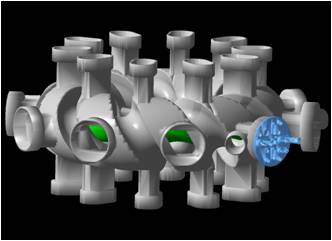
Scientific visualization of both simulation result and experimental device
data. This is the view from outside of LHD vessel device.Simulation result
about LHD is obtained by MHD simulation, and pressure profile is shown
as green isosurface. |
"Simulation of feedback instability in the coupled magnetosphere-ionosphere system"
Hiroki Hasegawa, Nobuaki Ohno, and Tetsuya Sato,
Journal of Geophysical Research Vol.115, A08304 (2010)
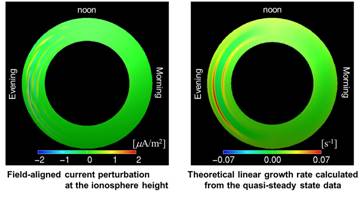
The left panel shows the distribution of the field-aligned current density
perturbation at the ionospheric height, which is obtained by a nonlinear
simulation. The right panel represents the distribution of the linear growth
rate calculated from the quasi-steady state data through the integrated
feedback instability theory. This figure indicates that the areas where
longitudinally striated structures appear are consistent with the prediction
by the theory. |
"Influences of ballooning modes with moderate wave number on MHD equilibrium
in LHD"
H. Miura and N. Nakajima,
Nuclear Fusion Vol.50, 054006 (2010)
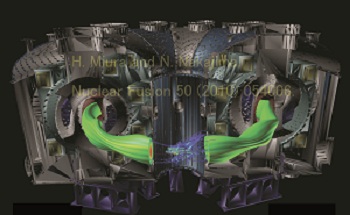
A 3D view of a full-3D MHD simulation of LHD. Contours of the pressure
are drawn on the poloidal cross-section.The red region represents β = p/(B02 /2) = 3.7% , while the green colour is p/(B02 /2) = 1%. |
"Magnetic Reconnection Controlled by Multi-Hierarchy Physics in an
Open System"
R. Horiuchi, S. Usami, H. Ohtani, and T. Moritaka,
Plasma and Fusion Research Vol.5, S2006 (2010)
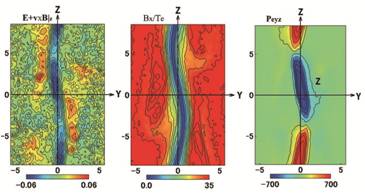
Spatial profiles of E + ve x B (left), Bx/Te (middle), and off-diagonal component of electron pressure tensor Peyz (right) in the (y, z) plane in the presence of drift-kink instability. |
"Improved Open Boundary Model for Plasma Particle Simulations"
Hiroki HASEGAWA and Tetsuya SATO
Plasma and Fusion Research Vol.5, 020 (2010)
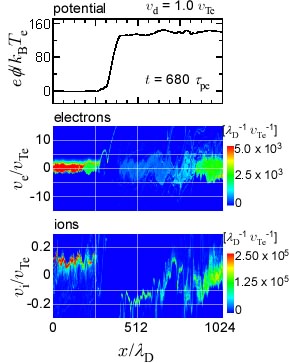
This figure shows the result of a test simulation. The top, middle, and
bottom panels present the spatial profile of electric potential and distributions
of electrons and ions in space-velocity phase space, respectively. This
result indicates that double layer creation by ion-acoustic instability
also occurs in a case where the electron drift velocity is comparable to
the electron thermal velocity. |
| 2009年 |
"First Demonstration of Collisionless Driven Reconnection in a Multi-Hierarchy Simulation"
S. Usami, H. Ohtani, R. Horiuchi, and M. Den,
Plasma and Fusion Res. Vol.4, 049 (2009)
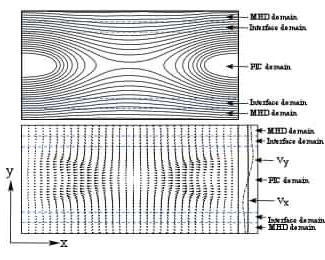
Magnetic lines of force and fluid velocity vectors in a multi-hierarchy simulation. |
"Equation-Free Coarse Grained Projective Integration Method for Multi-Scale
Plasma Simulation"
ISHIGURO Seiji and SKORIC Milos, M.
J. Plasma Fusion Res. Vol.85, 593-596 (2009)
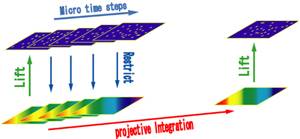
Concept of Equation-Free Projective Integration Method. |
"Relativistic Laser-Plasma Interactions"
Milos M. Skoric
AIP Conf. Proc. Vol.1188, 15-34 (2009)
NEW DEVELOPMENTS IN NONLINEAR PLASMA PHYSICS
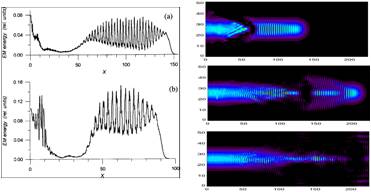
Snapshots of spatial laser pulse energy from 1D Fluid (left) and 2D PIC
(right) simulations show strong spatial modulation, depletion and pulse
break-up due to backward SRS. |
"Generation control of fast electron beam by low density foam for FIREX-I"
H. Sakagami, T. Johzaki, H. Nagatomo, and K. Mima
Nucl. Fusion, Vol.49, 075026 (2009)
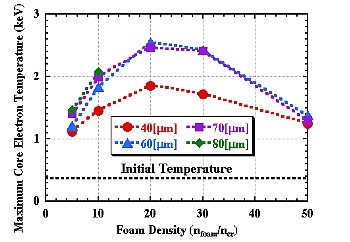
Maximum averaged core electron temperatures as a function of foam density.
Red circle, blue triangle, purple square and green diamond indicate the
foam thickness of 40, 60, 70 and 80 micron, respectively. |
"Open Boundary Condition for Particle Simulation in Magnetic Reconnection Research"
H.Ohtani and R.Horiuchi
Plasma and Fusion Research Vol.4 (2009) 024.

Comparison of the results of short (top) and long (bottom) -simulation boxes to check whether the open boundary condition fulfills its function. The results of the short -simulation box effectively mimic those of the long -simulation box. |
"Analytic high-beta tokamak equilibria with poloidal-sonic flow"
A. Ito and N. Nakajima,
Plasma Phys. Control. Fusion Vol.51, 035007 (2009)
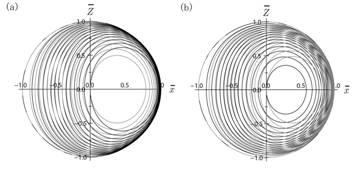
Pressure isosurfaces (black) and magnetic flux surfaces (gray) for (a)
sub-and (b) super-poloidal-sonic flows. |
| 2008年 |
"Electron Force Balance in Steady Collisionless-Driven Reconnection"
B. Li and R. Horiuchi,
Physical Review Letters Vol.101, 215001 (2008)
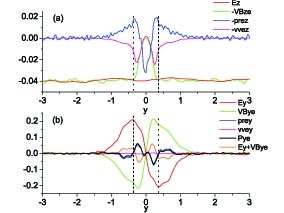
Spatial profiles of each term in the z direction(top) and inflow direction
(bottom) of the electron momentum equation along the vertical line passing
the X point in the steady state. |
|
|
|
 研究所WEBへ
研究所WEBへ 研究所WEBへ
研究所WEBへ